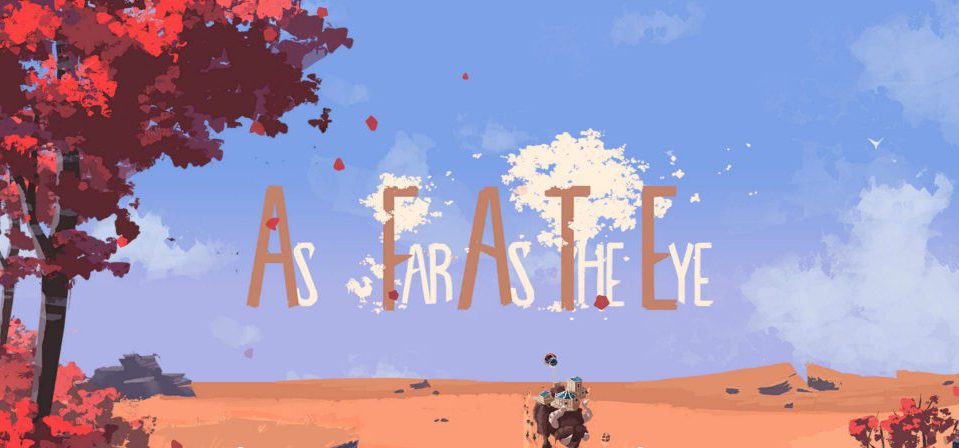Lovely graphics and music provide a window into a beautiful world that’s plagued by cyclical floods … and very poor game balance.
Type: Single-player
Genre: Simulation, Strategy
Developer: Unexpected
Publisher: Goblinz Studio,
Maple Whispering Limited
Release Date: 11 Sep, 2020


Introduction
As Far As The Eye (sic) is a turn-based resource-management game set in a weird sort of fantasy world, from developers, Unexpected. It’s due to be released in a day or two as of the time of this review, so my words here are based on a pre-release version. I’m hoping it’s going to be in Early Access for a while, because it really does need more work.
Anyway, you play The Sigh — the wind — and your goal is to save the various tribes of pupils (people) from the rising floods that inundate the land on a cyclic basis, by directing them to harvest resources in order to make their way to The Eye: a sort of sanctuary from the encroaching waters.
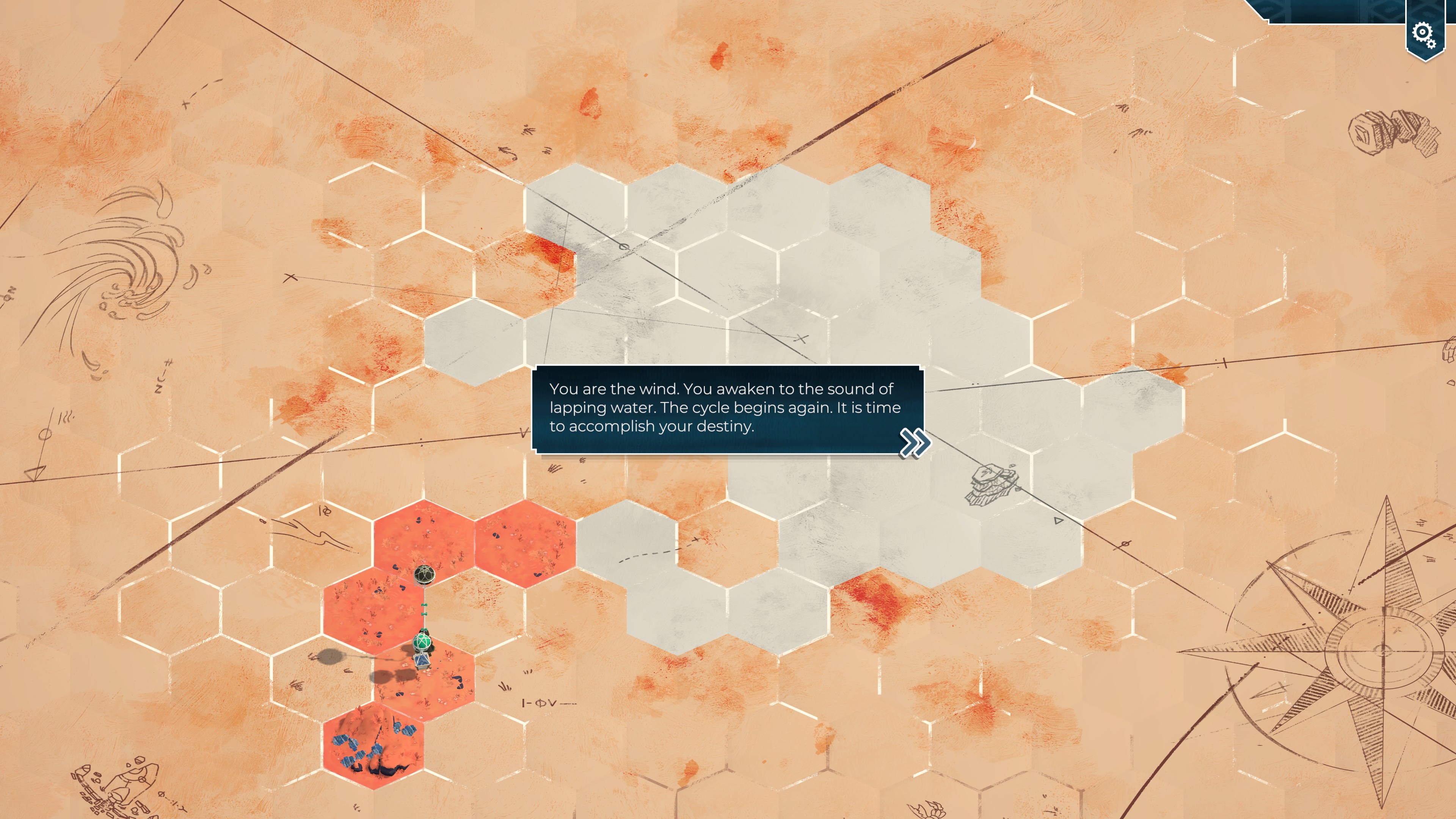
The Game World
The world in which As Far As The Eye is set is an interesting one, with all sorts of unfamiliar words and terms for things that you’ll just have to get used to if you want to understand what’s going on. Each level is a “halt”, for example, and each androgynous person is a “pupil”, making his or her way slowly to The Eye in the caravan: actually a single beast of burden carrying your pupils and their stuff, at least to begin with. It’s mostly consistent and makes sense, eventually, but at least when starting out I was getting lost in all this completely unfamiliar terminology, without even a basic glossary or tooltips to explain what things mean.
That said, it’s not actually that important to understand all of the flavour text, as long as you grasp the gameplay basics. And the whole idea of playing “The Sigh” is really just a bit of a gimmick; you have direct control over each pupil in ways that aren’t obviously related to the wind.
The game also uses the singular “they” to refer to each pupil, which I personally found very jarring, given that in each context it would have been easy to assign a gender pronoun — either traditional or some sort of game-world-specific one. This made the text even harder to parse. Relatively frequent grammatical errors and some untranslated French, together with a number of screens where text is simply cut off mid-sentence, further confound understanding, which is a bit of a shame given the effort that otherwise seems to have gone into producing the unique game world. I didn’t really feel a great sense of immersion, in any case.
To make it worse, pupils have absolutely no individual personality. They’re each given a weird name and one positive and one negative trait: more action points, or limitations on their harvesting abilities, for example. They make no individual responses, react exactly the same to everything, and — other than their traits — are each exactly as good as the other at doing everything. To me they just ended up being “the builder”, “the food harvester”, “the miner”, and so on. It seemed like a wasted opportunity.
Presentation
The beautiful watercolour-style graphics of the static title screen, supported by lovely mellow minimalist ambient music that hints at the relaxing adventure that should follow, provide an excellent first impression of As Far As The Eye. (Though the pedant in me demands that the capitalisation is incorrect!) The pleasant graphics and musical style both continue through into the game proper, with a relaxing soundtrack and unique 3D graphics with impressive hand-drawn materials.
The main game is played on a hex grid, with undiscovered hexes being drawn like plain paper, with occasional blemishes or scribbles on it. As you uncover these hexes they’re populated with one of a small number of terrain types — hills, plains, mountains, and so on — and also sometimes with little models representing harvestable resources. The caravan looks like a large, lumbering, but mostly pleasant beast, while the pupils themselves are the least engaging of the game’s animated models: little non-descript colour-coded humanoids. Though their resource balloons are sort of cool. It’s sometimes hard to tell in exactly which hex a pupil is positioned — a serious issue for a turn-based game in which movement costs are based on hexes moved through — so I’d recommend the developers address this somehow; perhaps highlighting the current hex or using some sort of fade or transparency to indicate it.
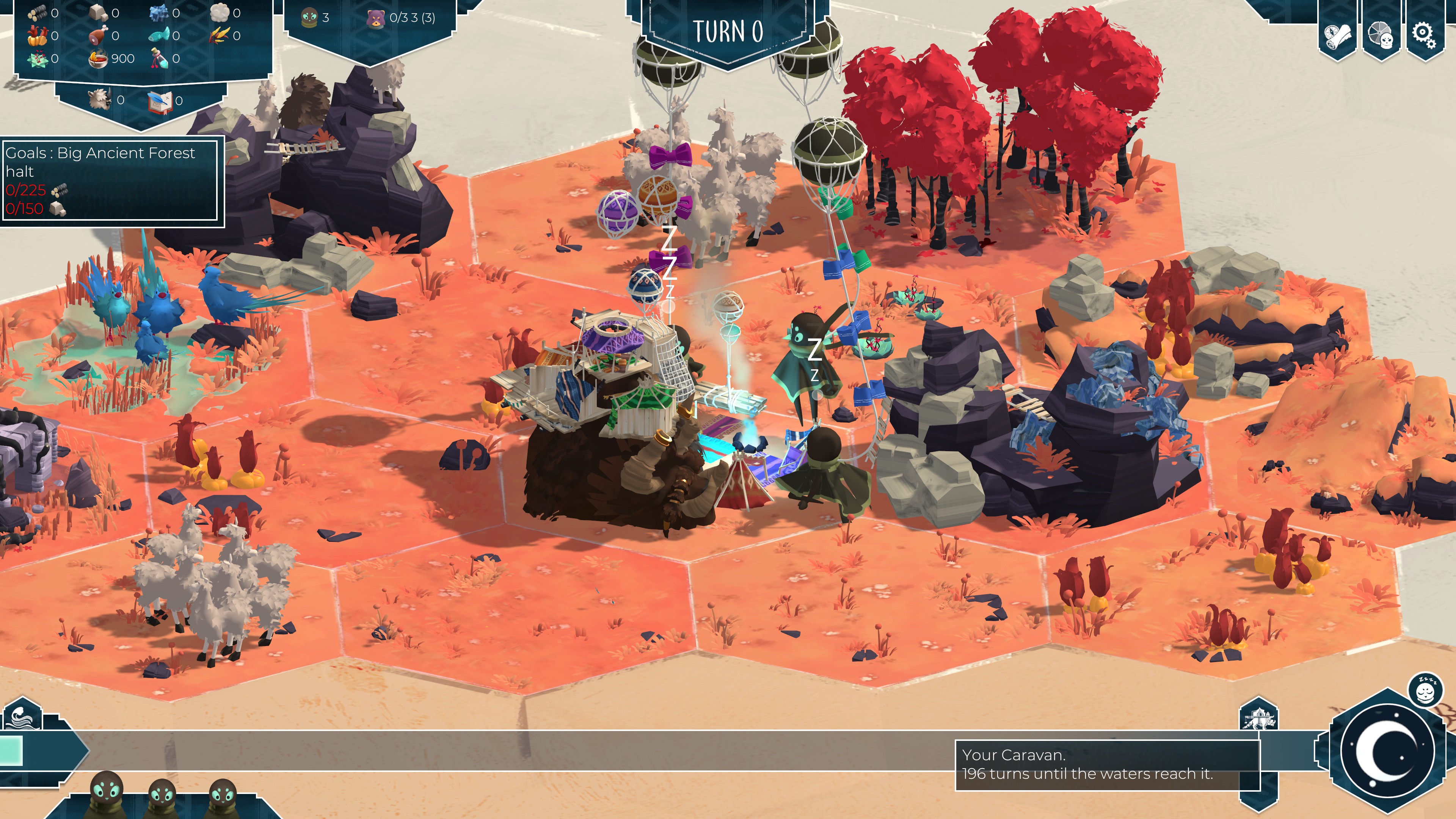
You can zoom and rotate the main view, but I found the rapid change of angle from almost-top-down to almost-side-on rather disconcerting when zooming in close to ground level; this should be adjusted, I think, to not be so sudden. The hexes seem to change shape between full zoom levels, too — a side effect of the chosen field of view, perhaps? I found it weird, anyway.
Most of the interface is consistent in its cool-blue style, though for some reason the main settings menus are different in plain black and a different font, and stick out like a sore thumb.
I played with all graphics options at maximum at 3840×2160 on a Radeon 5700 / i5-based system and didn’t encounter any serious performance issues.
Game Modes
The game features two game modes: “Campaign” and “Play”. Yes, “Play” is one of the options.
To make it even more confusing, “Campaign” is actually the four-mission tutorial — which, by the way, seems to be broken — while “Play” is the main game mode — the campaign, as I would call it. Um … .
Anyway, both modes introduce you to the game through the use of series of dialog boxes explaining the basics of the game world and how to play, and, while the tutorial (“Campaign”) limits the effects of some of the game’s more evil design decisions, both modes effectively present the same game with the same goals: collect resources in order to move through a series of stages until you reach the safety of The Eye.
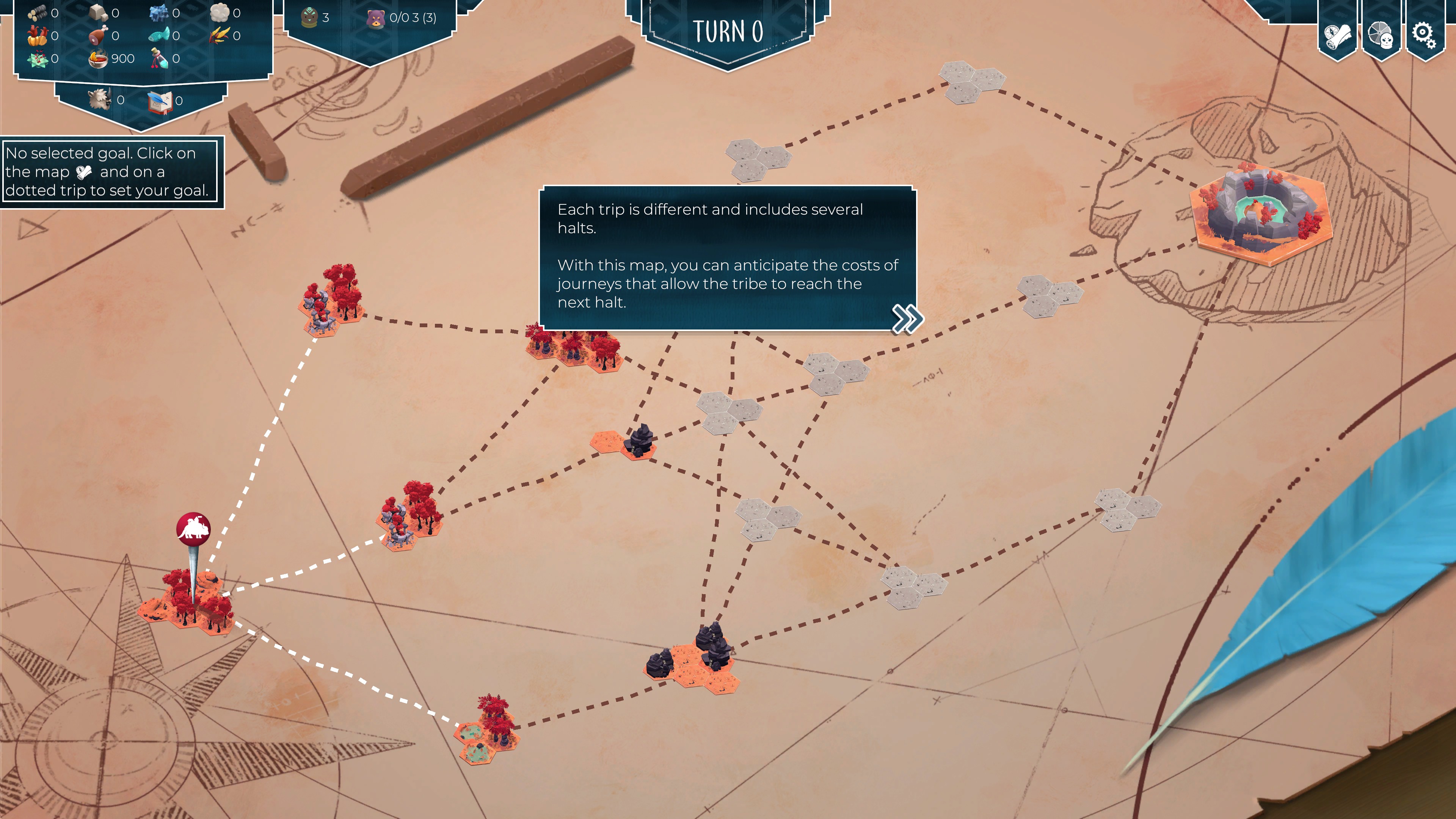
The actual campaign mode (“Play”, not “Campaign” — sheesh!) offers a slightly different experience each time you play, through the use of those most common of Rogue-like elements: procedural generation and permadeath. In this mode you’re given three pupils to lead on their journey to The Eye and your path there is different each game. I believe the tutorial (“Campaign”) is more structured and is the same each time you play it. It’s worthwhile playing through the tutorial once, I think, as long as the developers fix it so it’s actually able to be completed.
Turn-based RNG Management
While the game’s store page mentions turn-based resource management as being the name of the game, once I started playing the game proper (i.e. _not_ the campaign mode), I most often found the actual resource management aspects of the game being rapidly overwhelmed by RNG factors over which the player has no control.
Each run has you starting with one of four tribes (only one is available to begin with; each of the others is unlocked, I think, by succeeding with the previous) and needing to make your way across the world map, through a procedurally generated series of halts — levels, remember? — to reach The Eye, where presumably the game ends. I say presumably because I haven’t made it that far.
Each halt itself is procedurally generated, too, made up of hexes, each of a certain terrain type and potentially containing an object or resource. The requirements to proceed to the next halt along your chosen path to the Eye also appear to be procedurally generated: typically collecting a large amount of certain types of resources, or training a pupil to a certain level on the skill tree.
So most of the game is spent on each individual halt, finding a location for your caravan and moving your pupils around to collect the resources required to progress, or to build intermediate structures that will let you then harvest what you need to progress, before the specified turn limit when the halt is flooded with water and your pupils all die horribly.
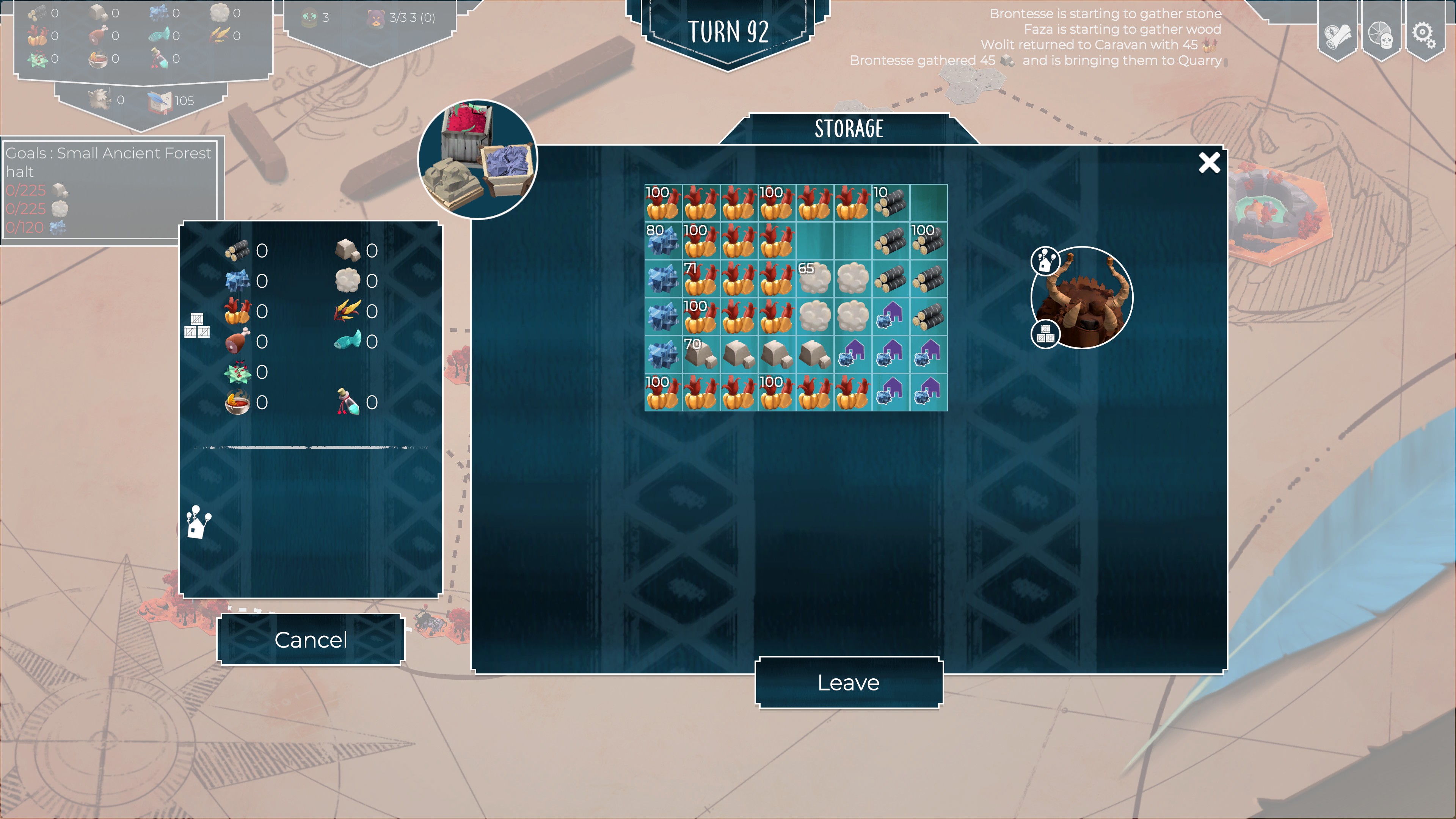
As well as the resources required to progress to the next halt, your pupils can also harvest further resources to take with them, ostensibly to make the next halt easier. As your caravan — plus any new beasts of burden you manage to drag along on your journey — has limited storage space, however, you then get to play an ARPG-inventory-management-style of minigame, where you have to cram as many items of different numbers and shapes of inventory slots in as you can.
Along the way your pupils gain experience in the various activities they undertake, eventually — if you build the right buildings and the game doesn’t immediately take them away from you again — allowing them to specialise. This improves their effectiveness at their specialist tasks, effectively further limiting your decisions — you’re almost always better off having the most trained pupils in each task do it, after all.
There’s no traditional conflict — no combat or aggression — so you’d be forgiven for thinking that the gameplay would be mellow or casual. Instead the challenge is supposed to be in managing your pupils and resources efficiently in order to beat the turn limit for the halt. Oh, and the food limit! Yes, each pupil consumes six units of one of the food resources every turn. Go without food for a turn and they get sick and start to lose HP. After a few turns of that, they’re dead. Game over.
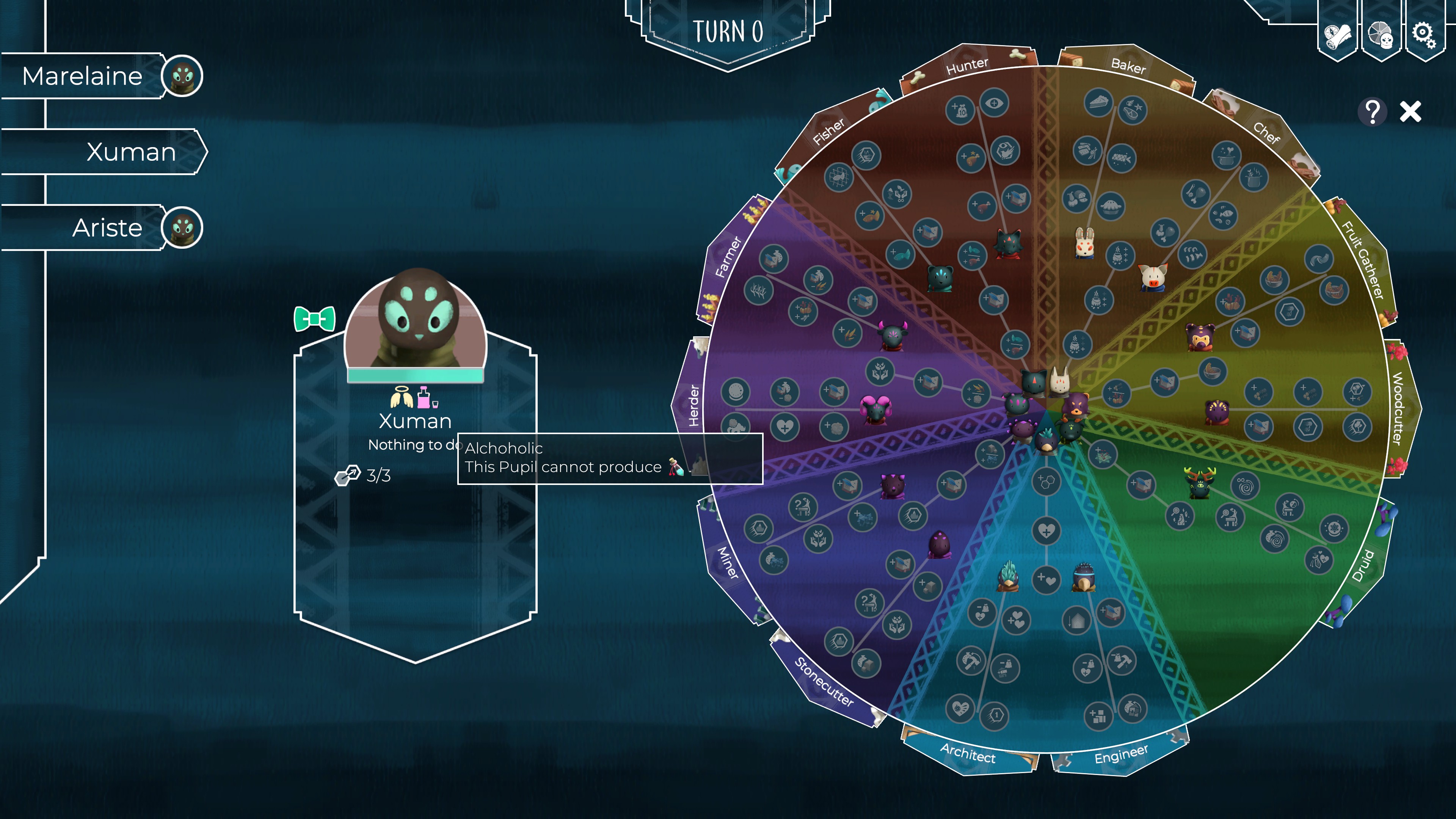
What this means, at least when you’re starting out, is that you basically need to discount one pupil entirely from any activity other than food collection. While you have a good stock to start with, within a halt or at most two, it’ll all be gone — especially since you need to find space to cart it with you each time you progress. This makes the much-more-generous flood turn limit completely irrelevant, at least early on, since lack of food will kill you long before the halt turn limit expires. Especially if you’re lucky enough to get one of the halts with requirements that simply can’t be met. Hooray!
So the challenge is actually fourfold, and actual resource management doesn’t really figure into it most of the time, though I don’t think that’s the way it’s intended to be: 1) occasional impossible progression requirements, 2) halt turn limits, 3) food turn limits, and 4) “vagaries”. I’ll explain the vagaries next; they’re so bad they need their own section.
Vagaries
Vagaries are pseudo-randomly generated events that occur mostly using the rising waters as a nonsense plot hook. They’re all bad, or at least I’ve not yet seen a beneficial one, and they’re game changing. I’d probably call them game breaking in many cases. Even worse is that the RNG seems to be used vindictively for vagaries, in that every game I played it ramped up them so rapidly after I started making any reasonable progress that each game became a basically impossible gauntlet run of frequent randomly generated ass-kicking events. To make them even worse still, Vagaries are only announced a turn or two before they come into play, unless you’ve progressed to the point where you can detect them earlier (good luck with that). And that’s typically not enough time to efficiently cope with a vagary’s effects, assuming that it’s a vagary that _can_ even be dealt with reasonably.
I started simply calling them “fuck-yous”.
You see, some vagaries are relatively benign or easily dealt with by simply avoiding them, such as “bog mosquitoes”, which make any pupils passing through a bog for the next 10 turns get sick; or all miners getting sick of boredom. Others, though, can completely destroy any planning and progress you’ve made in a matter of a turn or two, with absolutely nothing you can do about it. Need stone to progress? Built a quarry at last? Guess what: that quarry is now on fire and you can’t repair it because you need … stone! Better go back to the map and see if you can find another path to The Eye. Need food to progress — or, given the six-food-per-pupil-per-turn tax on playing anyway, even if you don’t? Guess what: a rat just ate over 600 units of food in one turn, and you couldn’t do anything about it. Game over. Or maybe all of your harvesters get sick of boredom; there’s not much you can do about that when you need food to survive!
Vagaries are completely unbalanced and very poorly thought out, and most often seem to be there just to punish you for making progress. I usually love the introduction of Rogue-like elements in games, with procedural generation and permadeath being two of the core ones, but when they’re this unbalanced and completely unavoidable, they don’t add anything to the game. All they do is make me rage quit, every fucking time I try to play the game!
State of the Game
So I’m still not sure whether As Far As The Eye is going to launch into Early Access or straight into full release. I’m assuming Early Access, since it has a number of “coming soon” placeholders, requires some major rebalancing, and is one of the more insidiously bug-ridden games I’ve played recently.
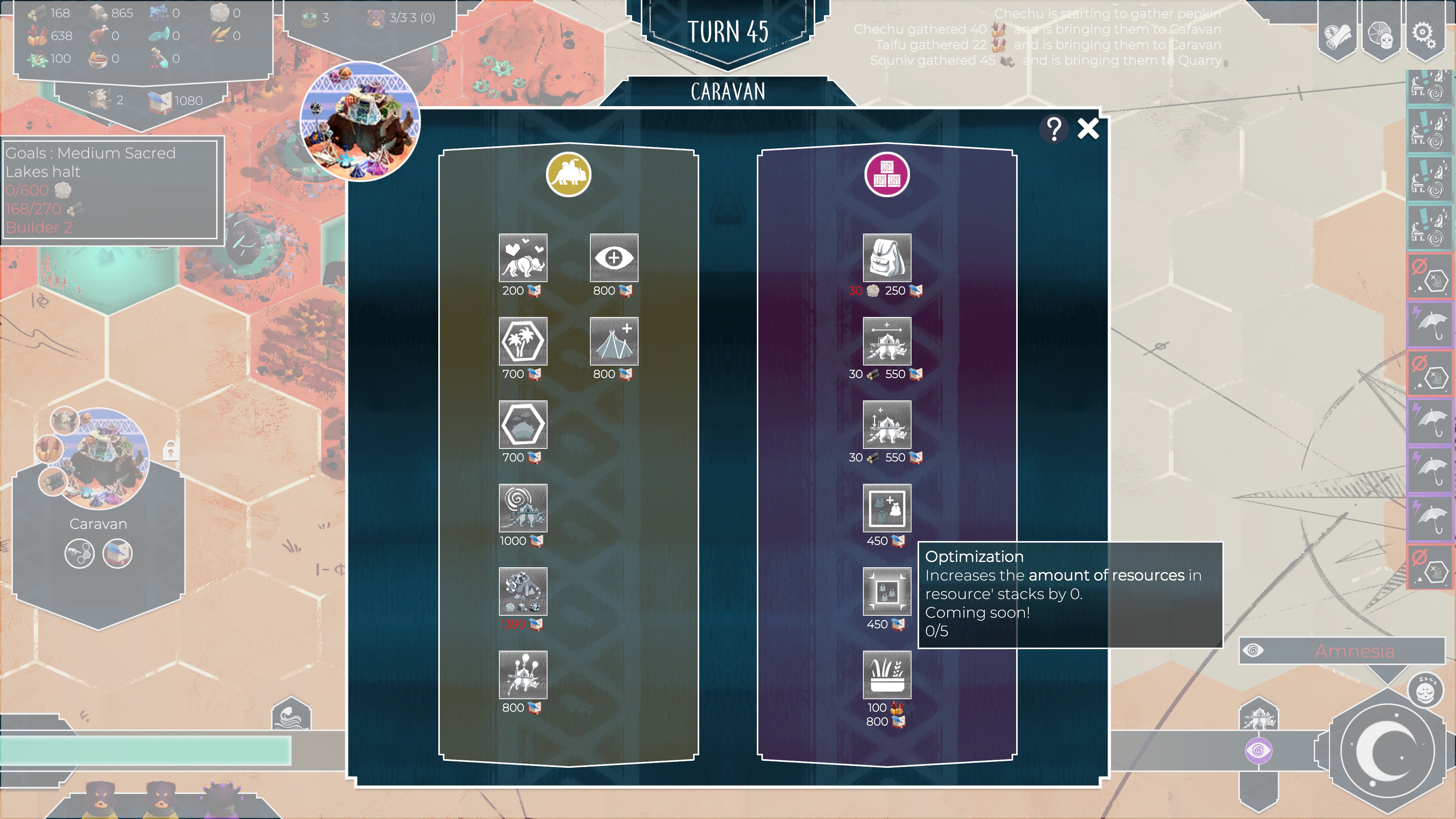
The interface is broken in a number of ways, from uncloseable dialogs that cover key elements of the screen, requiring a restart to remove them; to infinitely repeating messages that don’t allow the game to progress at all: “Krak died from sickness” really didn’t need to be repeated ad infinitum, and you know, it would have been nice if you’d told me he was sick at all in the first place! Oh, and that Remains hex I found that claimed I’d get whatever resources I wanted from it? It didn’t give me anything!
Halt sizes seem to be incorrect occasionally, with “small” halts sometimes outsizing “medium” or even “large” ones, and that tendency of the game to give you requirements that are impossible to meet is pretty annoying, too. That’s made even worse by the unexplained occasions when a stockpiled resource just magically begins to disappear, with no word or warning given as to why. And one of the few tribe knowledge point bonuses I bought — to decrease the trading costs — only worked the first time I opened the trading window; after that all the prices reverted back to their initial values. For that matter, why is trading so expensive? Aren’t all of these tribes supposed to be basically working together? Shouldn’t we be giving these resources away at rock-bottom prices to help our fellow pupils? As it is, the exchange rates are just too grindy to be worthwhile, and don’t make sense in terms of the game world.
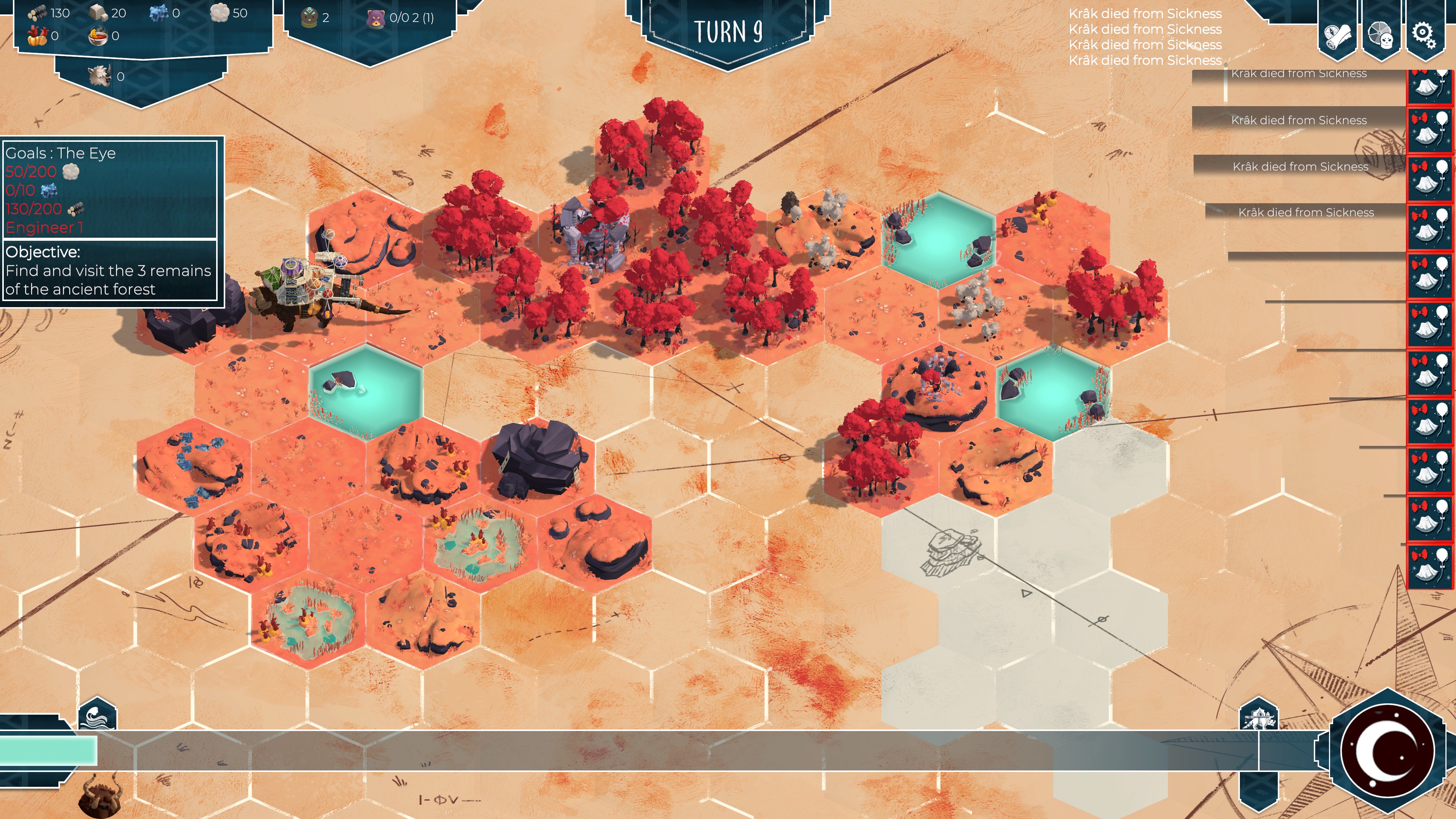
I’d also love to see some quality-of-life improvements, such as settings for food consumption and vagary appearance rates, advance vagary warning times, useful tooltips, a trade window that caps out at the amount of goods you have to offer, and even a glossary. These would all make the game much more likeable, and don’t seem like they’re asking for much. An auto save would be great, too — or at the very least a warning when you’re about to quit and cause a lot of effort to be wasted. (Campaign, I’m looking at you!) Oh, for that matter, change “Play” to “Campaign”, since it is, and change “Campaign” to “Tutorial”, since it is, too. And remove the conflicting advice in the tutorial: one section tells you to only take what you need, while the next tells you to take as much as you can carry to the Eye. Which is it!?
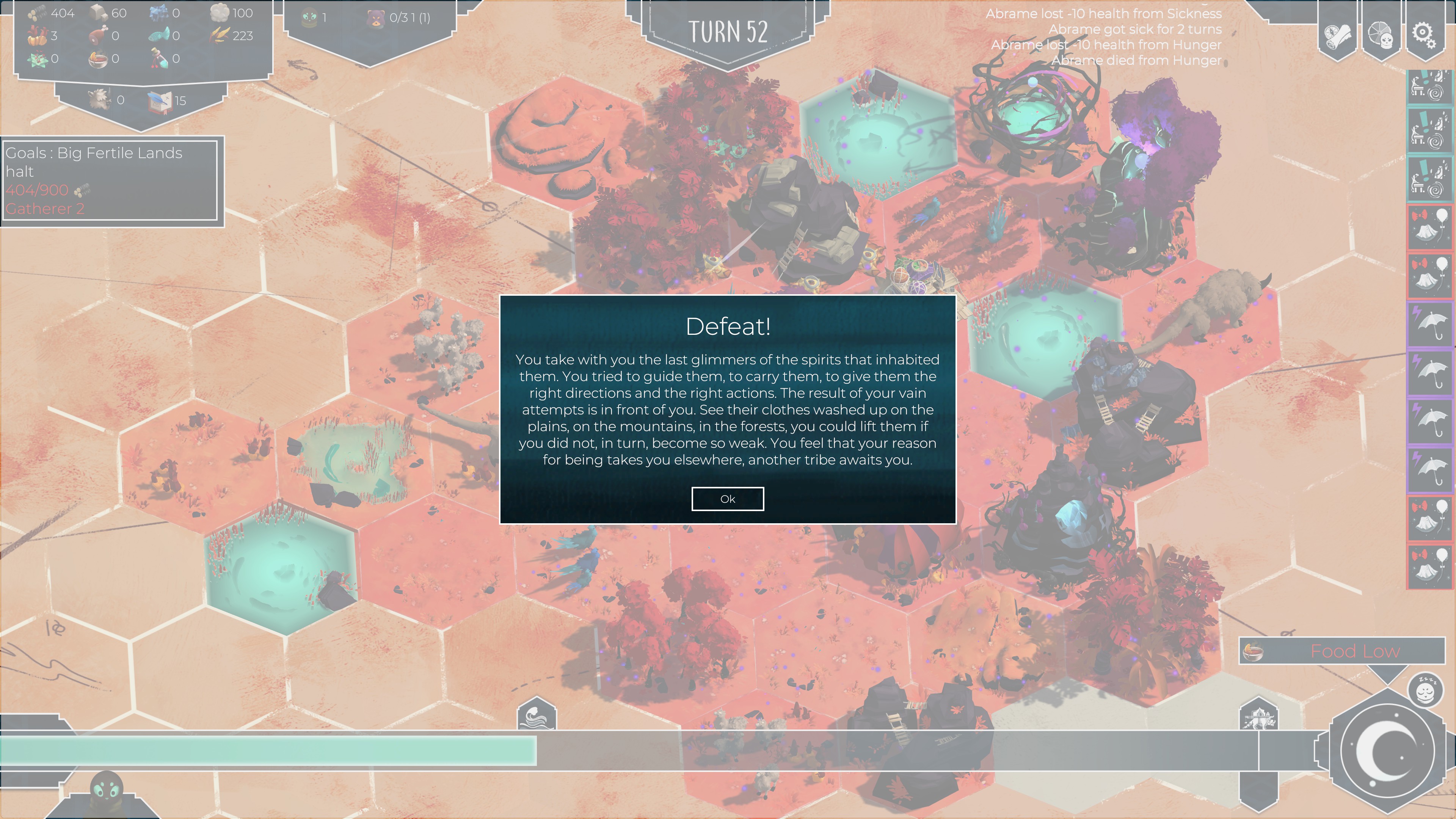
Verdict
I want to really like As Far As The Eye, but I just don’t.
While its turn-based nature; lovely, light and frolicky music; pretty, colourful graphics; and lack of combat make me think that it should appeal to a relaxed and casual play style, I find myself getting uncomfortably stressed while playing it, when I’m not bored. I would usually love the character development and Rogue-like aspects of the game, but here I find them unbalanced and poorly implemented. All in all, it feels too fiddly and cumbersome to enjoy, and the continual drain on food resources alone is enough to make me quit in frustration. Combine that with the game breaking bugs, unbeatable levels, and reliance on vindictive RNG, and I’ve ended up rage quitting almost as many times as I’ve started the game.
It’s beautiful and complex, and I’m happy to believe it becomes more enjoyable as you play more of it — at least if you’re very patient, lucky, or both. But it’s not very much fun to begin with, and, try as I might, I haven’t been able to force myself over that first hump. Every time I play I quit in frustration after half an hour or so, and that’s just not fun; the game has worn out its welcome before it’s had a chance to shine.

